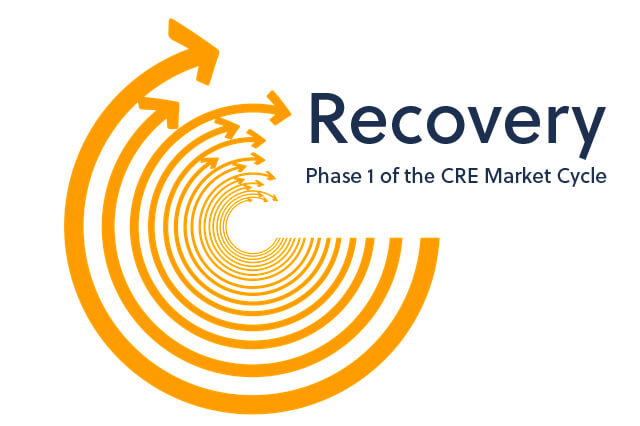This is part one of a four-part series on the commercial real estate market cycle.
| Phase 1 – Recovery | Phase 2 – Expansion | Phase 3 – Hypersupply | Phase 4 – Recession |

While any investment entails risk, it is possible to invest successfully across all four phases of the cycle. In order to do so, it’s crucial to have a clear investment strategy and to understand the current state of the market.
Before reading the articles in this series, it’s best to have a solid grasp of the three general categories of properties that commercial real estate investors strategically target. If you aren’t yet familiar with the terms core properties, value add properties and opportunistic properties, take a few minutes to read Three CRE Investment Strategies. This article will use those terms and discuss how investors with different strategies can approach the first phase of the CRE market cycle, recovery.
Phase 1 – Recovery
“The darkest hour comes right before the dawn” is a well-worn saying. Since the market’s recovery phase begins at the darkest economic hour – the low point of a recession – it can be difficult to identify. At that point, there’s little new construction to be found and the crippling effects of the recession can still be felt acutely by job seekers as well as cautious lenders. Yet the beginning of a recovery phase presents great opportunity for investors who recognize it for what it is – and act.
Core
- Investing in core properties during the recovery phase can be very profitable.
- The Ideal core property will include a significant number leases rolling over in the next 2-3 years. This will make it possible to raise lease rates as businesses enjoy the acceleration of the recovery and demand for space rises.
- Cash flow can also be increased by leasing up any space left vacant during the recent recession.
- If you can do both of those things successfully, you’ll be in a great position should you choose to refinance or sell the property during the expansion phase.
Value Add
- The recovery phase can be a great time to purchase value add properties just as they are poised to see significant appreciation.
- You will need significant capital up front, as value add properties will generally require improvements in order to fetch the highest possible price, should you look to sell during the expansion phase.
- This approach requires patience during the recovery phase, as well as a carefully considered business plan. Lease up will take longer than with core properties.
Opportunistic
- Distressed properties can be scooped up at bargain prices if you move early in the recovery phase.
- This does entail significant risk and trying to get access to capital at a time when lenders are still feeling the effects of the recent recession.
- You might target a 2-4 year holding period in which you seek to significantly improve the property and then sell during the expansion period.
- Keep an eye on the area surrounding an opportunistic property. Is it ripe for development? Increased activity and value in the surrounding area can drive up the value of your property significantly.
- Purchasing raw land during this phase can pay off significantly down the road, but the risk can be very high and barriers to necessary capital even greater.
Opportunity to invest successfully exists during all four phases of the commercial real estate market cycle. Educate yourself and reach out to a MontanaCRE commercial real estate advisor for more information.
This is part one of a four-part series on the commercial real estate market cycle.
| Phase 1 – Recovery | Phase 2 – Expansion | Phase 3 – Hypersupply | Phase 4 – Recession |



